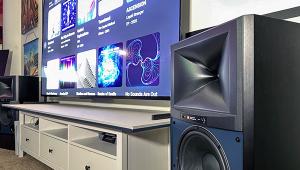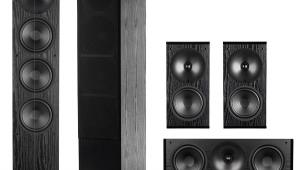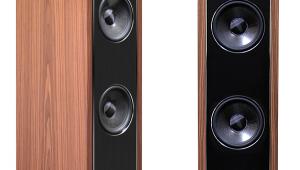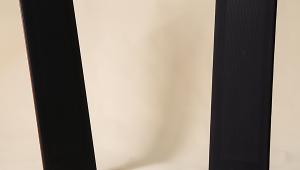Test Report: Paradigm Monitor Series 7 Speaker System Page 2
Performance
Beginning as always with full-range stereo music from the Monitor 9s alone, I was immediately impressed. These are extended, smooth, and accurate speakers — I began typing “unexpectedly so,” but that would be untrue.
What I heard was in fact not in the least surprising: vocal octaves that were impressively smooth, honest, and virtually free of any distinct colorations; top octaves that were evident and “easy,” without any “splash,” “tizz,” or extra sparkle, and bass that extended effortlessly to the lowest bass guitar notes (around 40 Hz) and even a bit further.
In short, as a full-range stereo reproducer, the Monitor 9s are very, very good. My only reservation was that their overall balance in my room was a bit warmer and a bit more bass-centric than I had expected. Pulling them out 4 feet or more from the wall helped this substantially, but the 9s still sounded a bit heavier in the 40- to 160-Hz range than I prefer.
Even so, on bass-rich but complex music like Paul Simon’s “Pigs, Sheep, and Wolves” (from 2000’s You’re the One), the Paradigms still sounded “quick,” detailed, and agile — even while producing playback levels that offered sternum-smacking kickdrum. (In fact, the Monitor 9s played ridiculously loud and clean in stereo. In a bigger room, like mine, serious power can be put to serious use without aural repercussions.)
Adding in the DSP-3200 sub, with a crossover of 70 Hz, mitigated the mild bass emphasis I had heard just about entirely — once I’d run the Perfect Bass Kit. A nice feature of Paradigm’s software enables you to fine-tune the “target curve” crossover point, which I lowered a half-octave or so from the automatic finding (to 165 Hz), as a prophylactic anti-bloat measure.
A quick replay of the Simon track confirmed the efficacy of these measures: The slightly “thuddy” character of the big drum (some sort of African hand drum, I imagine) was gone, leaving a cleaner, “quicker,” more pitch-discriminated timbre.
And the DSP-3200 did nothing to detract from the Series 7 system’s musical abilities — though the Monitor 9s go deep enough strongly enough that its only really substantial contribution is the very bottom-most octave and a half, a rare visitor in most music. Nevertheless, combined together in a surround-music showcase such as Hanson’s Bold Island Suite (from a Telarc SACD that’s one of my go-to music surround demos), the bottom line was impressively close to perfect.
The Series 7’s Center 3 proved as close a match to the Monitor 9s as you’re likely to find. Tonal character of both male and female announcers was very similar, and the big center-channel unit promises the kind of dynamic abilities that true, reference-level cinema sound demands: both virtues that, with few exceptions, only bulkier, three-way centers like Paradigm’s achieve. An equally important boon, also unique (or nearly so) to such three-way centers, was the Center 3’s outstanding off-axis consistency. I had to move well beyond the prime listening/viewing spot to hear noticeable shifts in vocal colors.
Putting this all together on film sound proved profoundly satisfying. Star Wars: Episode III — Revenge of the Sith is a true reference-quality Blu-ray. The battle scene spanning Chapters 3 to 5 or 6 — oh, hell, the whole damned movie — is thus a hoary chestnut of A/V demo rooms, but I can’t dispute the DTS-HD Master Audio soundtrack’s success in packing every sort of effect, plus a superbly recorded orchestral score — and some of the clunkiest dialogue ever written — into a 10-minute serving.
I deliberately sampled this sequence before running Perfect Bass, and it sounded big, clean, and dynamic, but weighted by a tablespoon of the dread “home theater boom” that plagues so many installations, including, depressingly, many high-end ones. Post-Perfect Bass this was gone, and the Sith sequence sounded reference-quality top to bottom. I’ve screened these scenes in Skywalker Sound’s own 300-seat Stag Theater on a couple of occasions, and while I’m not saying that the Paradigm setup equaled the experience (not much could), the resemblance was sufficient to raise occasional goosebumps on even these thoroughly jaded forearms.

























































